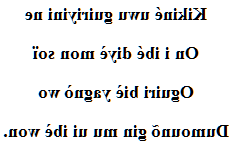Dogon love poem
Kikiné uwu guiriyini ne
On i ibé diyè mon soï
Oguiri biè yagnò wo
Dumounõ gin mu ui ibè won.


→ French poem ←
Dogon language
Dogon love poem (Dogosso), the language of Dogon people mainly in Mali, Ivory Coast and Burkina Faso.
This language is the Niger-Congolese language of a pretty Malian woman. I give my poem to all girls of Bamako and to the 600,000 dogons who essentially cultivate and forge, and could understand it.
Dogon, a voltaic language in fact brings together more than fifteen dialects which are not necessarily inter-understandable. Unfortunately, I do not know in which one precisely this translation is.
Here are a few: Toro So, Jamsay, Ana Tinga, Mombo, Yanda Dom, Tiranige Diga, Dogul Dom, Ampari, Toro Tegu, Bondum Dom, Tebul Ure, Bankan Tey, Nanga Dama, Bunoge, Donno So, Tomo Kan, Tene Kan, Ben Tey, Tommo So!
Among the Dogons, there is a secret language, the Sigi So. The ancients teach it to the youngest this language which is used during religious ceremonies. I hope that one day someone will send my poem in this language :-).
Their art, their philosophy, their ancient beliefs and their knowledge, especially in medicine and astronomy, are recognized as an African essential to human thought.
In the cavities of the cliffs near their habitat, we find signs and symbols, painted or engraved, representing in an abstract way, objects or notions, of great symbolic richness.
These signs and symbols are the traces of an "ancient writing" whose object was more magical than material.
The Dogons
According to tradition, Dogons are from Mandé, which in the 14th was the center of the Mali empire. They had elaborated an extremely complex cosmogony, based on the belief in a creative god Amma, and a creation from the movements of the "egg of the world".
They were divided into 4 tribes hierarchized politically and religiously, born of the 4 pairs of primordial twins, headed by chiefs called Hogons. There were endogamous groups of blacksmiths and weavers.
The Dogons were structured in patrilineal and patrilocal lineages. Their territorial organization conforms to the myth of the world in the form of a spiral. The Hogon, personifying the order of the universe, was the guarantor of rituals, law and commerce.
Mali is made up of 6 large ethnic groups spread over the whole territory. The north is a desert, so it's to the south that the population is concentrated and that there are many traces of ancient civilizations.
The Dogons live in villages hanged to the cliffs. This typical habitat was a natural refuge against their enemies, the Peuls. The slope to reach it is generally marked with ropes to grip it.